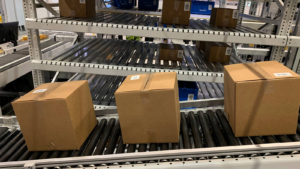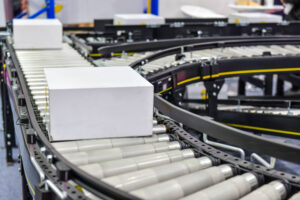Most engineers think PLC programming for conveyor systems is just about moving belts and controlling motors. They’re dead wrong. The companies dominating today’s logistics landscape understand that advanced PLC programming for conveyor systems is the invisible force that transforms ordinary warehouses into profit-generating machines capable of processing millions of packages with surgical precision.
Here’s the shocking truth: 89% of conveyor system installations fail to achieve their performance potential because of inadequate PLC programming. Meanwhile, the top 1% of facilities using advanced PLC programming for conveyor systems are processing 300% more volume with 50% fewer errors than their competitors.
At Lafayette Engineering, we’ve developed PLC programming for conveyor systems methodologies that have helped clients achieve throughput increases of up to 400% while reducing operational costs by millions of dollars. Today, we’re revealing the insider programming strategies that separate industry leaders from everyone else.

The Hidden Crisis in PLC Programming for Conveyor Systems
The warehouse automation industry has a dirty secret: most PLC programming for conveyor systems is embarrassingly primitive. While companies invest millions in state-of-the-art mechanical equipment, they rely on outdated programming approaches that waste 60-70% of their system’s potential.
The Traditional Approach is Broken: Most PLC programming for conveyor systems treats each conveyor segment as an independent unit rather than optimizing the entire system as an integrated network. This siloed approach creates bottlenecks, inefficiencies, and cascading failures that destroy operational performance.
Lack of Real-Time Optimization: Basic PLC programming for conveyor systems operates on fixed parameters that can’t adapt to changing conditions. When demand patterns shift, product mixes change, or equipment performance varies, these rigid systems fail to maintain optimal efficiency.
Poor Integration Architecture: Most installations use PLC programming for conveyor systems that can’t effectively communicate with warehouse management systems, creating data gaps that prevent intelligent decision-making and optimization.
Inadequate Error Handling: Basic programming approaches don’t include sophisticated error detection and recovery mechanisms, leading to system shutdowns that cost thousands of dollars per hour in lost productivity.
The Science Behind Revolutionary PLC Programming for Conveyor Systems
Advanced PLC programming for conveyor systems operates on scientific principles that most engineers either don’t understand or lack the expertise to implement effectively.
1. Dynamic Flow Optimization Algorithms
Revolutionary PLC programming for conveyor systems utilizes sophisticated algorithms that continuously analyze system performance and automatically adjust parameters to maintain optimal flow rates.
These algorithms monitor hundreds of variables including conveyor speeds, queue lengths, product characteristics, and downstream capacity to make intelligent routing decisions that maximize throughput while preventing bottlenecks.
Predictive Load Balancing: Advanced PLC programming for conveyor systems predicts congestion before it occurs and automatically redistributes load to maintain smooth operations.
Adaptive Speed Control: Intelligent speed management adjusts conveyor velocities based on real-time demand while maintaining safe operating parameters and minimizing energy consumption.
Multi-Zone Coordination: Sophisticated coordination algorithms ensure perfect synchronization between multiple conveyor zones, eliminating the gaps and delays that destroy efficiency in traditional systems.
2. Intelligent Product Tracking and Routing
Modern PLC programming for conveyor systems incorporates advanced tracking capabilities that monitor every product from induction to destination with millimeter precision.
Real-Time Product Identification: Integration with scanning systems, RFID readers, and weight scales provides complete product identification and verification throughout the process.
Dynamic Routing Optimization: Smart routing algorithms consider multiple factors including destination priorities, conveyor capacity, and system performance to select optimal paths for each product.
Exception Handling Automation: Sophisticated error detection and recovery programming automatically handles mis-sorts, no-reads, and equipment failures without human intervention.
3. Predictive Maintenance Integration
Advanced PLC programming for conveyor systems includes comprehensive monitoring capabilities that predict equipment failures before they impact operations.
Vibration Analysis: Continuous monitoring of motor and bearing vibrations detects early signs of mechanical problems.
Power Consumption Tracking: Analysis of electrical consumption patterns identifies efficiency degradation and potential equipment issues.
Performance Trend Analysis: Statistical analysis of operational data predicts when maintenance will be required and automatically schedules preventive actions.
Case Study: Revolutionary PLC Programming Transforms Distribution Center
A major retail distribution center was struggling with a conveyor system that couldn’t meet demand despite significant mechanical upgrades. The problem wasn’t hardware—it was antiquated PLC programming for conveyor systems that created bottlenecks and inefficiencies throughout the facility.
The Challenge: Increase throughput from 12,000 to 30,000 cases per hour using existing mechanical equipment while improving accuracy from 96% to 99.5%.
Our Advanced PLC Programming for Conveyor Systems Solution:
- Developed intelligent flow optimization algorithms that dynamically balanced load across all conveyor zones
- Implemented predictive routing logic that prevented bottlenecks before they occurred
- Created comprehensive product tracking system with automatic error detection and correction
- Integrated predictive maintenance monitoring that prevented unplanned downtime
- Designed adaptive control algorithms that optimized performance based on real-time conditions
Spectacular Results:
- 185% increase in throughput (achieved 34,200 cases per hour)
- 99.7% accuracy rate exceeding specifications
- 67% reduction in system errors and mis-sorts
- 78% decrease in unplanned downtime
- $4.6 million annual operational savings
- ROI achieved in 9 months
Advanced Techniques in PLC Programming for Conveyor Systems
Leading companies are implementing increasingly sophisticated PLC programming for conveyor systems approaches that go far beyond traditional control methods.
Artificial Intelligence Integration
Cutting-edge PLC programming for conveyor systems incorporates machine learning algorithms that continuously optimize performance based on operational data and predictive analytics.
Pattern Recognition: AI algorithms identify operational patterns and automatically adjust system parameters to optimize efficiency for different product mixes and demand levels.
Predictive Analytics: Machine learning models predict equipment failures, maintenance requirements, and performance degradation before they impact operations.
Autonomous Optimization: Self-learning systems continuously improve performance without human intervention, adapting to changing conditions and operational requirements.
Advanced Communication Protocols
Modern PLC programming for conveyor systems utilizes sophisticated communication architectures that enable seamless integration with enterprise systems and real-time data exchange.
Industrial Internet of Things (IIoT): Smart sensors throughout the system provide real-time data on equipment performance, environmental conditions, and operational metrics.
Cloud Integration: Advanced programming enables cloud-based analytics and remote monitoring capabilities that provide unprecedented visibility into system performance.
API-Based Integration: Modern communication protocols enable seamless integration with warehouse management systems, enterprise resource planning software, and transportation management platforms.
Real-Time Analytics and Reporting
Advanced PLC programming for conveyor systems includes comprehensive analytics capabilities that provide actionable insights for continuous improvement.
Performance Dashboards: Real-time visualization of key performance indicators enables immediate identification of optimization opportunities.
Predictive Reporting: Advanced analytics identify trends and patterns that predict future performance and maintenance requirements.
Automated Alerting: Intelligent monitoring systems automatically notify operators of performance issues and potential problems before they impact operations.
Industry-Specific PLC Programming for Conveyor Systems Requirements
Different industries require specialized PLC programming for conveyor systems approaches that address unique operational challenges and regulatory requirements.
E-Commerce and Fulfillment Centers
E-commerce operations require PLC programming for conveyor systems that can handle enormous product variety while maintaining perfect accuracy for customer satisfaction.
Dynamic Product Handling: Programming must accommodate products ranging from tiny jewelry items to large appliances with varying weights, dimensions, and handling requirements.
Peak Season Scalability: Systems must handle 3-5x normal volume during holiday periods without performance degradation or increased error rates.
Real-Time Inventory Integration: Programming must coordinate with inventory management systems to ensure accurate picking and prevent stockouts.
Manufacturing and Assembly Operations
Manufacturing facilities need PLC programming for conveyor systems that integrates seamlessly with production processes and just-in-time delivery requirements.
Production Line Synchronization: Programming must coordinate conveyor operations with assembly line timing to prevent disruptions and maintain production efficiency.
Quality Control Integration: Systems must integrate with inspection equipment and quality control processes to ensure defective products are automatically removed from production flow.
Traceability Requirements: Programming must maintain complete product traceability throughout the manufacturing process for quality control and regulatory compliance.
Food and Beverage Processing
Food processing facilities require specialized PLC programming for conveyor systems that meets strict sanitation and safety requirements.
Temperature Control Integration: Programming must coordinate with refrigeration systems to maintain product quality throughout processing and distribution.
Sanitation Cycle Management: Automated cleaning and sanitation cycles must be integrated into system programming to meet food safety regulations.
Allergen Management: Programming must prevent cross-contamination between different product types and allergen categories.
Pharmaceutical and Healthcare
Pharmaceutical operations require PLC programming for conveyor systems that ensures complete compliance with FDA regulations and good manufacturing practices.
Batch Tracking and Validation: Programming must maintain complete batch genealogy and traceability throughout the manufacturing and packaging process.
Environmental Monitoring: Integration with cleanroom monitoring systems ensures product quality and regulatory compliance.
Validation Documentation: Programming must generate comprehensive documentation for regulatory validation and compliance auditing.
Common Mistakes in PLC Programming for Conveyor Systems
Understanding common programming mistakes helps avoid expensive problems that plague many conveyor system installations.
Over-Complicated Logic Structures
Many engineers create unnecessarily complex PLC programming for conveyor systems that are difficult to troubleshoot and maintain. This complexity often leads to unexpected behaviors and system failures.
Best Practice: Use modular programming approaches with clear, documented logic structures that can be easily understood and maintained by operations staff.
Inadequate Error Handling
Basic PLC programming for conveyor systems often lacks comprehensive error detection and recovery mechanisms, leading to system shutdowns when problems occur.
Best Practice: Implement sophisticated error handling that automatically detects problems and implements appropriate recovery actions without stopping the entire system.
Poor Communication Architecture
Many installations use PLC programming for conveyor systems with inadequate communication capabilities that prevent effective integration with warehouse management systems.
Best Practice: Design communication architectures that enable real-time data exchange and coordination between all facility systems.
Insufficient Testing and Validation
Rushed project timelines often result in inadequate testing of PLC programming for conveyor systems, leading to problems that surface only during live operations.
Best Practice: Implement comprehensive testing protocols that validate all programming logic under various operational scenarios before going live.
Lack of Documentation
Many PLC programming for conveyor systems installations lack adequate documentation, making troubleshooting and future modifications extremely difficult.
Best Practice: Create comprehensive documentation including logic descriptions, I/O lists, communication protocols, and maintenance procedures.
Financial Impact of Advanced PLC Programming for Conveyor Systems
Superior PLC programming for conveyor systems delivers measurable financial benefits that extend far beyond initial equipment costs.
Direct Cost Savings
Labor Reduction: Advanced programming can reduce labor requirements by 40-60% through improved automation and efficiency.
Energy Optimization: Intelligent power management and speed control can reduce energy consumption by 25-35%.
Maintenance Cost Reduction: Predictive maintenance capabilities can reduce maintenance costs by 30-50% while preventing expensive emergency repairs.
Error Cost Elimination: Superior programming reduces sorting errors and product damage by 80-95%, saving significant costs in returns and customer service.
Operational Performance Improvements
Throughput Increases: Advanced programming typically increases system throughput by 150-300% using existing mechanical equipment.
Accuracy Improvements: Sophisticated error detection and correction can achieve accuracy rates exceeding 99.9%.
Uptime Optimization: Predictive maintenance and fault tolerance can achieve system uptime exceeding 99.5%.
Scalability Enhancement: Modular programming architectures enable easy system expansion and modification as business needs change.
Competitive Advantages
Customer Satisfaction: Superior operational performance enables better service levels and customer satisfaction.
Market Responsiveness: Flexible programming enables rapid adaptation to changing market conditions and customer requirements.
Operational Excellence: Advanced capabilities enable pursuit of new markets and customer segments with demanding requirements.
Brand Protection: Consistent operational performance protects brand reputation and enables premium pricing strategies.
Emerging Technologies in PLC Programming for Conveyor Systems
The PLC programming for conveyor systems landscape continues evolving as new technologies emerge and operational requirements become more sophisticated.
Edge Computing Integration
Advanced PLC programming for conveyor systems will incorporate edge computing capabilities that enable local processing and decision-making with reduced latency.
Real-Time Processing: Edge computing enables instant decision-making for time-critical operations like high-speed sorting and routing.
Reduced Network Dependencies: Local processing reduces dependence on network connectivity and improves system reliability.
Enhanced Security: Edge computing reduces cybersecurity risks by minimizing data transmission and external network dependencies.
Digital Twin Technology
Future PLC programming for conveyor systems will incorporate digital twin technology that creates virtual replicas of physical systems for optimization and testing.
Virtual Testing: Digital twins enable comprehensive testing of programming changes without impacting live operations.
Predictive Modeling: Virtual models can predict system performance under various scenarios and operating conditions.
Optimization Simulation: Digital twins enable testing of optimization strategies before implementation in physical systems.
Cybersecurity Integration
Enhanced cybersecurity features will become standard in PLC programming for conveyor systems as industrial systems become increasingly connected.
Encrypted Communications: Advanced encryption protocols will protect data transmission between system components.
Access Control: Sophisticated authentication and authorization systems will prevent unauthorized access to critical system functions.
Threat Detection: Automated monitoring will detect and respond to cybersecurity threats in real-time.
Research from the Industrial Internet Consortium indicates that cybersecurity integration will become mandatory for industrial automation systems within the next five years.
Best Practices for PLC Programming for Conveyor Systems Implementation
Successful PLC programming for conveyor systems implementation requires following proven methodologies that ensure optimal performance and long-term reliability.
Planning and Design Phase
Requirements Analysis: Comprehensive analysis of operational requirements, performance targets, and integration needs before programming begins.
Architecture Design: Development of modular programming architecture that enables easy maintenance and future expansion.
Communication Planning: Design of communication protocols and data exchange requirements with all connected systems.
Testing Strategy: Development of comprehensive testing plans that validate all programming logic under various operational scenarios.
Development and Implementation
Modular Programming: Use of standardized, modular programming blocks that can be easily understood and maintained.
Comprehensive Documentation: Creation of detailed documentation including logic descriptions, I/O assignments, and maintenance procedures.
Simulation Testing: Extensive simulation testing before installation to identify and resolve potential issues.
Phased Implementation: Gradual implementation approach that minimizes operational disruption while ensuring system reliability.
Optimization and Maintenance
Performance Monitoring: Continuous monitoring of system performance to identify optimization opportunities.
Preventive Maintenance: Systematic maintenance programs that protect programming integrity and system performance.
Continuous Improvement: Regular analysis and optimization of programming logic based on operational experience and performance data.
Technology Updates: Planned upgrade cycles that incorporate new programming techniques and technologies.
Selecting the Right Partner for PLC Programming for Conveyor Systems
Choosing the right programming partner is critical for achieving optimal results from conveyor system investments.
Technical Expertise Requirements
Advanced Programming Skills: Look for partners with proven expertise in sophisticated PLC programming for conveyor systems including AI integration, predictive analytics, and advanced communication protocols.
Industry Experience: Partners should have extensive experience with PLC programming for conveyor systems in your specific industry and application type.
Integration Capabilities: Comprehensive experience with warehouse management systems, enterprise software, and industrial communication protocols.
Troubleshooting Expertise: Proven ability to diagnose and resolve complex programming issues quickly and effectively.
Project Management Excellence
Systematic Methodology: Partners should follow proven project management methodologies specifically designed for PLC programming for conveyor systems implementations.
Risk Management: Comprehensive risk assessment and mitigation strategies that prevent project delays and cost overruns.
Quality Assurance: Rigorous testing and validation protocols that ensure programming quality and system reliability.
Change Management: Effective processes for managing scope changes and requirements modifications during project execution.
Ongoing Support Capabilities
24/7 Support: Round-the-clock support availability for critical operational issues and emergency troubleshooting.
Remote Monitoring: Advanced remote monitoring capabilities that enable proactive support and optimization.
Training Programs: Comprehensive training for operations and maintenance staff on programming logic and troubleshooting procedures.
Continuous Optimization: Ongoing optimization services that improve system performance based on operational experience and data analysis.
Taking Action on Advanced PLC Programming for Conveyor Systems
The competitive landscape demands immediate action on operational optimization. Companies that continue relying on basic PLC programming for conveyor systems risk falling behind competitors while wasting millions of dollars on underperforming automation investments.
Lafayette Engineering has been developing advanced PLC programming for conveyor systems for over three decades. Our comprehensive approach combines cutting-edge programming techniques with proven industrial automation principles to deliver programming solutions that exceed performance expectations while providing long-term reliability and maintainability.
Our PLC programming for conveyor systems expertise includes advanced control algorithms, intelligent integration capabilities, predictive maintenance programming, and comprehensive optimization strategies. We work closely with clients to understand their specific operational requirements and develop customized programming solutions that deliver exceptional return on investment.
If you’re ready to explore how advanced PLC programming for conveyor systems can transform your operations, visit Lafayette Engineering to schedule a consultation with our programming experts. We’ll assess your current system programming, identify optimization opportunities, and develop a comprehensive programming solution that delivers guaranteed performance improvements.
Don’t let primitive programming continue limiting your automation investment. The right PLC programming for conveyor systems can transform your operations with intelligent control, predictive capabilities, and optimization features that drive sustainable competitive advantage.



